|
The French Model 1886 Lebel Rifle |
|
|
|
|
|
CRUFFLER.COM
presents
HISTORIC
FIREARM OF THE MONTH,
November
2001:
|
The French Model 1886 Lebel Rifle |
|
|
|
|
System of Operation: Manual Caliber: 8x50mmR Capacity: 8 rounds in under barrel tube + one in carrier + one in chamber Sights, front: Grooved Blade Sights, rear: U-notch on elevation adjustable ladder Length: 51" Weight (unloaded): 9 lbs 5 ozs Barrel: 31.5", 4 grooves, left hand twist |
|
|
In 1887 two more governments adopted small caliber tube magazine repeaters. Japan began to issue the 8x53mmR Murata Type 22 rifle, and Turkey the Mauser Model 1887, chambered for the 9.5x60mmR. The 9.5x60mmR is widely considered to have been the ultimate development of the black powder metallic rifle cartridge. Firing a 284 grain bullet with a muzzle velocity of 1,775 feet per second, the 9.5mm cartridge developed a muzzle energy of 1,987 feet per second. The 9.5x60mmR is considered by many to be the ultimate development in black powder metallic cartridges, offering impressive performance with a minimum of the severe powder fouling that plagued the the 8mm rifles. While the 9.5x60mmR could boast impressive performance for a black powder round, it was also evident that it was an evolutionary dead end. Velocities could not be increased much more without the rifling stripping the lead from the bullet as it traversed the bore, and the resultant combination of lead and powder fouling rendering the arm useless.
The problem of stripping had been addressed in 1881 by a Swiss soldier, Major Eduard Rubin, the director of the Swiss government munitions factory. Coming to the conclusion that the only way to reduce the fouling was to enclose the lead bullet in some sort of metal jacket that would be tough enough to resist stripping but soft enough to be engraved by the rifling, he proposed such cartridges to the Swiss Army. In 1883 Rubin submitted cartridges that used copper jacketed bullets in 7.5mm and 8mm calibers and compressed charges of black powder. As expected, the jacketed bullets reduced bore fouling, improved feeding, and allowed bullets to be pushed to even higher velocities. While the jacketed bullet was a great leap forward, the problem of black powder remained.
Black powder, in addition to producing clouds of smoke upon discharge, was responsible for a firing residue that not only fouled the bore but, by virtue of its hydrophilic properties, was highly corrosive as well. For years martial chemistry had been devoted to the development of a new propellant that would function without these ills. The nut was finally cracked in 1884 by a French chemist named Paul Vielle. Vielle solved the problem by using a common explosive, nitrocellulose (gun cotton). The nitrocellulose was dissolved in a mixture of ether and alcohol and dried into a sheet of plastic-like material that was then reduced to fine grains. As a result, the nitrocellulose was transformed into a form that could only burn from the surface inward. The rate of combustion was controlled by varying the size and shape of the grains
The advantages
to the new propellant were manifold. Muzzle velocities in excess
of 2,000 feet per second were now possible. The cloud of white smoke
that gave away soldiers' positions when they fired their rifles, and simultaneously
blinded them was a thing of the past. In one fell swoop, the French
were suddenly way ahead of every other nation. What they needed most
was a rifle that would take advantage of the new technology. The
French minister of war, General Boulanger issued orders for the design
of a small bore rifle, to be ready within three months, and to take advantage
of the new powder.
|
The contemporary French infantry rifle, the Fusil d'Infanterie M1885, which was an adaptation of the Kropatschek needed a few changes before it would function with the new propellant. To begin with, the smokeless propellant developed significantly higher pressures than black powder. Consequently it was necessary to lock the action with a mechanism stronger than the bolt root bearing against the receiver bridge. The M1885's bolt was a two piece design with a removable head. By replacing the original bolt head with one featuring dual opposed locking lugs, and modifying the receiver so that matching lug recesses were machined into it, the M1885 was made more than capable of handling the new smokeless powder cartridge. It was also given a new nomenclature - it would be known to the French as the |
The M1886 had a turn-bolt action with a two piece bolt. The bolt handle is straight. There is a square block of steel forged integrally with the bolt cylinder at its forward end and on the same plane as the bolt handle. It projects forward far enough to bear against a cam surface cut into the left side of the receiver ring when the bolt handle is lifted, providing primary extraction. The dual opposed locking lugs are on the bolt head
| which is fastened to the bolt body through the previously mentioned block with a machine screw. The bolt head is recessed to take the head of the rimmed case. The bolt body is bored out from the front to accept the bolt head and the striker spring. The rear portion of the bolt cylinder is bored just large enough to accommodate the striker passing through to the rear, where the cocking piece is mounted. The square shoulder provided at the point where the inside diameter of the bolt body is sharply reduced provides a bearing point for |
|
The major portion of the cocking motion takes place as the bolt handle is raised. The turning bolt exerts a camming effect on the cocking piece. Cocking is completed as the bolt is pushed fully forward and the sear
|
engages the forward edge of the cocking piece. The extractor is a short, flat spring dovetailed into the bolt head. The ejector is a screw head projecting from the left side of the receiver. The bolt is grooved to clear this screw head as the bolt is operated. The bolt stop is a square shoulder turned in the receiver. It operates against the rear surface of one of the locking lugs so that the bolt can only be withdrawn by unfastening the bolt head from the bolt cylinder. |
The trigger pull is of the two stage type. The sear is actuated by a v-shaped flat spring, where the top arm operates the sear and the bottom arm is pinned into the receiver. The sear is pivoted on the cartridge elevator axis pin.
The magazine
is a tube type mounted in the forearm. The magazine spring is a conventional
coil spring closed at the rear with a round plug that serves as a follower
to press the cartridges back toward the elevator. The elevator is
operated by camming and lever action exerted by the lower locking lug as
the bolt is moved backward and forward. The bolt handle exerts pressure
on the elevator to hold it down while the locking lugs are engaged in their
recesses in the receiver. The forward section of the elevator is
bent downward to form a finger which blocks the exit from the tubular magazine
until the elevator has been depressed to the loading position.
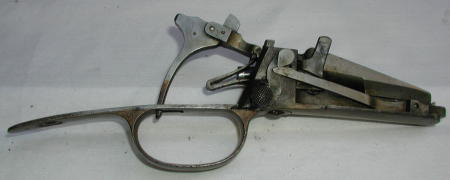
Lebel Trigger Group with Magazine Cut-Off in the off position, allowing magazine loading |
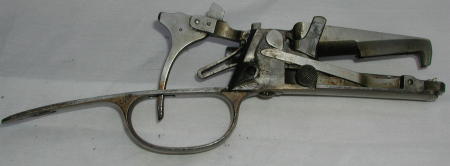
|
The receiver bridge is split to allow the bolt handle to pass through. The bottom of the receiver is closed with a floor plate onto which the elevator and sear mechanisms are mounted. The stock is a two piece type, and there is no handguard.
The new rifle fired a new cartridge, known as the Balle M. The Balle M, or 8x50mmR Lebel was basically a shortened and necked down 11x59mmR Gras case. The Balle M fired a 232 grain jacketed flat nosed bullet at a muzzle velocity of 2,050 feet per second. The Balle M was replaced in 1900 with the famous Balle D, a 198 grain spitzer boat tailed bullet with a muzzle velocity of 2,380 feet per second that was machined from a solid piece of bronze.
The French announcement of the adoption of the M1886 rifle reverberated through Europe like a thunderclap. The M1886 was, at a stroke, the single most modern small arm in any European arsenal, rendering all other designs obsolete at a stroke. Or was it? While it fired what was undoubtedly one of the most advanced cartridges of its time, the rifle itself was little more than an integration of very conservative design features. The basic action was little more than that of the Chatellerault arsenal's experimental M1885 design upgraded to handle smokeless powder ammunition. The most important modification, as noted earlier, was the fitting of a new bolt head with dual opposed lugs that locked into matching recesses in the receiver. Beside that change, the M1886 was right out of the mid 1870's. It had a massive and exposed rectangular receiver, straight bolt handle, a barrel in excess of thirty inches in length, a straight wrist buttstock and a tubular magazine. All these features combined to give the M1886 a silhouette unique among its peers.
The M1886's lines belie its nature. It just looks like it should be an ungainly thing with poor ergonomics. This is far from true. While long, the M1886 is an extremely graceful, well balanced rifle that points naturally, almost instinctively. Form follows function in all things with the M1886, and its length is no exception, allowing for an under barrel tube magazine capable of holding eight cartridges. Another round could be carried on the cartridge lifter, and one more in the chamber, making the M1886 a ten shot repeater. Not that this was nominally of much use - as with most other armies of the time, French tactics called for using the rifle as a single loader with the contents of the magazine held in reserve. A magazine cut-off was controlled by a lever on the right side of the receiver just in front of the triggerguard. When the lever was in the forward position, the cartridge carrier was disengaged from the lever which lowered it when the bolt was fully forward.
The M1886's sights are interesting and innovative. The rear sight is a wide U-notch, adjustable by ramp and leaf to 2,000m, while the front sight consists of a wide blade (that looks more like a sight base) with a groove machined into the top surface. The leaf could be folded forward along the barrel to expose a 250m
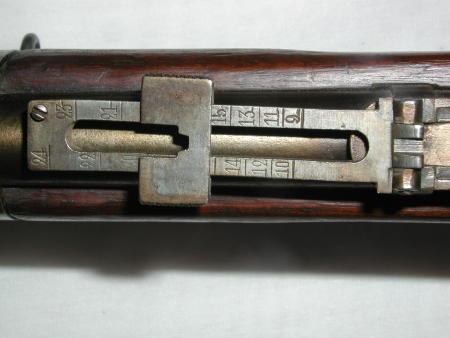
Lebel Rear Sight. Note battlesight and 2400m setting. Also note that it is canted to account for the bullet's drift at longer ranges caused by the rifling |
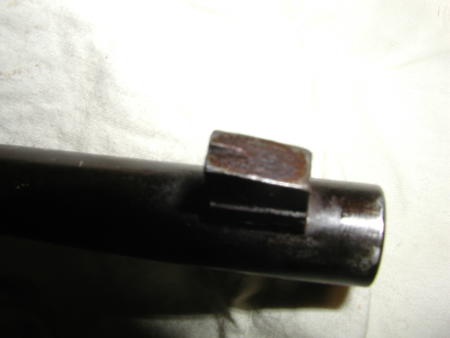
Lebel Front Sight. Note wide blade and groove. |
Once accepted for service, the Lebel was given priority of production at the government arsenals of Chatellerault, Saint Etienne, Tulle, and Saint Denis. By 1892, all regular infantry formations of the Metropolitan Army had been rearmed with the Lebel. In 1893, the firing pin, upper band and bolt head were modified. The official nomenclature was changed to reflect the modifications, and the new Lebel was christened the Fusil d'Infanterie Modele 1886/93. In 1898, a solid bronze, spitzer boat tailed bullet was adopted, designated the "Balle D." After the Balle D was adopted, all Lebel rifles were fitted with new rear sights that permitted an additional 400m of range adjustment.
The Lebel's first important combat use took place in 1900 with the French contingent that relieved the besieged foreign legations in Peking during the Boxer Rebellion. Experience during the Boxer Rebellion, and during service in France's Asian and African colonies indicated that the Lebel was rapidly becoming obsolete, especially when compared to the latest clip loading Mauser and Mannlicher designs. Adding insult to injury, the 8x50mmR's large rim, fat case, and sharp taper made it unsuitable as a machinegun cartridge. Finally, there was no practical way to shorten the Lebel to make a carbine for use by cavalry, engineer, artillery and rear area troops. Despite these shortcomings, the vast quantities of Lebels in service ensured that it would be the primary French longarm of the First World War.
World War One
was the Lebel's true baptism by fire, and by all accounts it held up extremely
well. Its major design flaw proved to be the tube magazine, which
allowed mud and dirt to enter the action during the lengthy time necessary
to reload. Despite the realization that the Lebel was overdue for
retirement, the exigencies of the First World War ensured that it would
remain in production for the duration of the war. In spite of itself,
the Lebel gave yeoman service, not only in the hands of the French poilus,
but also with French allies. Indeed, Russia, Belgium, Serbia, Rumania
and Greece all received tens of thousands of Lebels during the war.
Even the Germans used the Lebel, issuing large numbers of captured rifles
to rear echelon troops. Interestingly, even while the Lebel's successor,
the Berthier, was being issued by 1917, the Lebel was recognized as the
the more robust and accurate of the two rifles. As a result, even
in Berthier equipped regiments, four Lebels were found, equipped for both
grenade launching and, with the M1916 3X telescopic sight, for sniping.
The Lebel remained in production until 1919, with some four million being
produced.
|
But
the Lebel's story did not end in 1919. After the war they were supplied
to new French allies - states such as Poland and Czechoslovakia created
by the Treaty of Versailles. Additionally, many were purchased
on the surplus market by nations like Bulgaria and Turkey. French
colonial troops continued to use the Lebel well into the 1930's.
In 1924 the French developed the rimless 7.5x54mm cartridge which offered
better ballistics than the Balle D and was much more suited for use in
automatic weapons. Tests were carried out with Lebels converted to
the new cartridge, and the converted rifles were known as the M1886/93/27.
In the 1930's, the 8x50mmR was updated once more. The new variant,
christened the "Balle N" fired a 232 grain jacketed spitzer bullet at a
velocity of almost 2,500 feet per second (that's about 3,220 foot pounds
of muzzle energy, folks!). Most Lebels modified for the Balle N had
new sights installed, consisting of a standard blade front and a rear sight
with a narrow notch. All modified rifles had an N stamped on the
receiver and the barrel.
The final act in the Lebel's service career came with the issuance of the M1886/93/35 in 1935. This was a Lebel rifle with the barrel shortened to eighteen |
CONCLUSION
The Lebel
rifle occupies a salient place in firearms history. Not only was
it the first magazine repeating rifle chambered for a small bore, smokeless
powder cartridge with a jacketed bullet, but it can be argued that the
advent of the Lebel was responsible for the surge in rifle development
between 1888 and 1900 that yielded the Model 98 Mauser, the Short Magazine
Lee Enfield, and a spate of other designs. But the Lebel deserves
recognition in its own right. It is a soldier's rifle. Despite
its great length, the Lebel is extremely well balanced and a natural pointer.
Rugged, accurate and reliable, the Lebel withstood environmental conditions
that brought "modern" technological marvels like the Ross to their knees.
It also had one of the longest service lives of any military rifle, serving
the French military for almost sixty years. Was it perfect? Absolutely
not. But in the end, the Lebel proved to be "good enough" for all the challenges
it faced. And there is precious little more one can ask of any military
arm - much less the first one of its type!
 |
BIBLIOGRAPHY
Scarlata, Paul S., Collecting Classic Bolt Action Military Rifles, (Andrew Mowbray Publishers, Lincoln, Rhode Island: 2001)
Smith, W.H.B, The Book of Rifles, (Castle Books, New York: 1972)
Collecting
Classic Bolt Action Military Rifles is available from Andrew Mowbray
Publishers. Please click on the image to order.
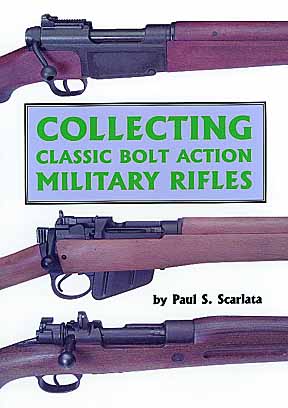
The Book
of Rifles is out of print but is available via rare and out of print
search engines such as Bibliofind.com.